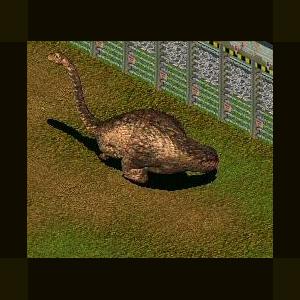About This File
Barapasaurus is curious because it is the earliest known sauropod, dating from the early Jurassic Period — more precisely the Toarcian age, about 189.6 to 176.5 million years ago. This is evident in the unspecialized nature of its form. Later sauropods like Brachiosaurus developed their own ecological niche and feeding strategies. However, Barapasaurus was something of an "all-purpose" dinosaur. For example, later sauropods developed hollow vertebrae, as a weight-saving measure. Barapasaurus vertebrae, on the other hand, were almost solid, with only the earliest hints of hollowing. (See also: Camarasaurus.)
Despite its early place in dinosaur history, Barapasaurus reached a length of about 18 metres (60 feet), and weighed about 48 tones (53 tons). Its height to the hip was approximately 5.5 metres (18 feet).
Like all sauropods, Barapasaurus was a herbivore. However, no skull has yet been recovered and so its exact diet has not been determined. A few lone teeth are known but not sufficient to make judgments on diet.
Barapasaurus is also important because, although its remains were found in India, it is very similar to other samples found in East Africa. From this we can conclude that during the early Jurassic period, these two land masses were still connected or at least only recently divorced.
Barapasaurus is included in Vulcanodontidae rather than Cetiosauridae, another family in Sauropoda. This classification is unconfirmed since insufficient work has been done on the skeletons. The description is justified by the narrow sacrum (a boxlike structure of the hip), which is a characteristic of vulcanodontids. However, the dorsal vertebrae display features shared with Cetiosauridae, such as a high neural arch above the vertebral foramen.
Currently the only known species is the original B. tagorsi.
The first bones of Barapasaurus were recovered in India in 1960. However, it was not until 1975 that this recovery was made the type specimen, and the official description published by Jain, Kutty, Roy-Chowdhury and Chatterjee of Calcutta.
Since then, five additional skeletons have been recovered from the Godavari Valley in southern India. However, none of these included the skull or feet. The remainder of the skeleton is known, so it is theoretically the best-known of the early Jurassic sauropods. Unfortunately, little work has yet been published regarding these discoveries.



Recommended Comments
There are no comments to display.
Create an account or sign in to comment
You need to be a member in order to leave a comment
Create an account
Sign up for a new account in our community. It's easy!
Register a new accountSign in
Already have an account? Sign in here.
Sign In Now